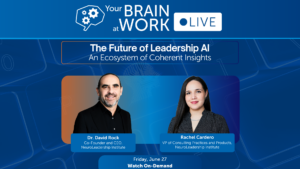In our previous blog post about designing effective leadership models, we spoke on the value of “stickiness.” That is, people can use the model because they remember it in the first place. But what if a model is sticky, and yet no one finds it relevant to the work they do?
That brings us to the second of our three key findings in our latest Idea Report white paper, “Building Brain-Friendly Leadership Models.” In order for models to be effective, models need to be both sticky and meaningful. Just accomplishing the first pushes your framework more into the realm of pop music or trivia—information we can’t get out of our heads, but ultimately does little for us. Having both increases your chances that people will draw on the right behaviors when they need guidance most.
Why meaningfulness matters
Over a nine-month period, NLI researchers interviewed 17 talent professionals and surveyed 568 leaders and individual contributors at different levels and in various industries. We asked them a range of questions about their organization’s leadership model and the extent to which it proved useful in guiding behavior.
Our data showed meaningfulness—the sense that the model is tied to something larger than the work itself—was often missing from many respondents’ experience. Even if they could remember the values and behaviors expected of them, they wouldn’t necessarily make use of those values and behaviors if they didn’t relate to the person’s specific role.
For instance, a learning designer may not derive much benefit from a framework pushing speed, since he or she knows learning takes time and the proper spacing. In order for the model to be meaningful, it has to appeal to the broader aspects of the learning designer’s role: the constraints, the challenges, and what makes it fulfilling.
The science of motivation
This coupling—expecting a positive outcome and feeling the outcome is valuable—is everything when it comes to motivation. Scientists refer to this one-two punch as expectancy and value. If we’re about to perform an action, we rapidly and repeatedly evaluate how much we care about the goal of the action (value) and whether we’ll succeed at the action (expectancy).
If just one of these falters, we may write the goal off as too lofty or not worth our time. For instance, New Year’s Resolutions tend to fail because (among other reasons), we may start to doubt whether we’re actually capable of accomplishing the goal or lose sight of its value as we sink back into the routines of everyday life. In that way, leadership models that are sticky but not meaningful offer expectancy but not value. We know we can succeed at executing the behavior, but what’s the point?
The upshot: Give your employees a leadership model that is both sticky and meaningful. Make it pithy, clever, and fluent in the brain. But don’t do any of that at the expense of tying those behaviors directly to the work people do. Often, that means generalizing the model enough so that it lifts up from individual roles, as NLI helps organizations do with our Leadership Principles work.
Of course, stickiness and meaningfulness only tell two-thirds of the story for designing brain-friendly leadership models. But more on that in our next post…
To learn more about NLI’s research on building brain-friendly leadership models, click the link below and grab your copy of the Idea Report today.
[action hash=”6521fba5-c8c2-41c9-ad0f-e30f2fd777e0″]






